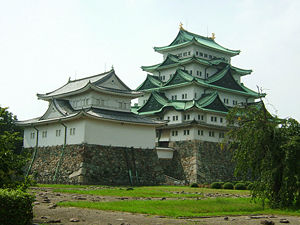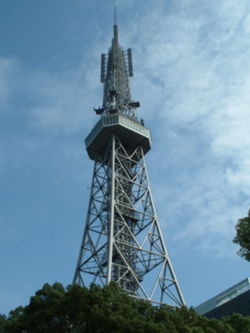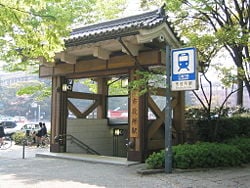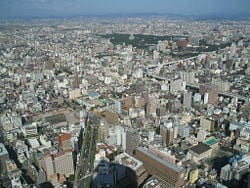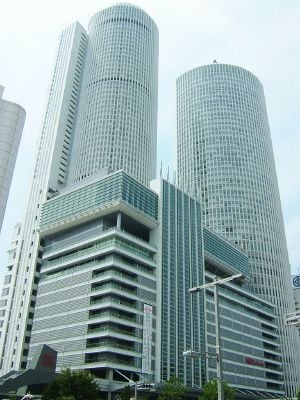Nagoya
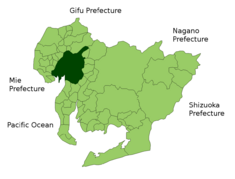 Nagoya City's location in Aichi prefecture, Japan. | |
| Location | |
| Country | Japan |
| Region | Chūbu |
| Prefecture | Aichi prefecture |
| Physical characteristics | |
| Population (as of 2006/12/1) | |
| Total | 2,225,866 |
| Symbols | |
| Tree | Camphor laurel (Cinnamomum camphora) |
| Flower | Lilium |
 Symbol of Nagoya City | |
| Nagoya City Hall | |
| Mayor | Takehisa Matsubara |
| Address | 〒460-0001 Nagoya-shi, Naka-ku, Sannomaru 3-chome 1-1 |
| Phone number | 052-972-2017 |
| Official website: Nagoya City | |
Nagoya (名古屋市 Nagoya-shi) is the fourth largest city in Japan. Located on the Pacific coast in the Chūbu region on central Honshū, it is the capital of Aichi Prefecture and is one of Japan's major ports along with those of Tokyo, Osaka, Kobe, Yokohama, Chiba, and Hakata. It is also the center of Japan's third largest metropolitan region, known as the Chūkyō Metropolitan Area (see also Chūkyō region). As of 2000, Chūkyō Metropolitan Area has 8.74 million people, of which 2.17 million live in the city of Nagoya.[1]
History
In 1610, Tokugawa Ieyasu moved the capital of Owari province from Kiyosu around seven kilometers to a more strategic location in present-day Nagoya.
A new large castle, Nagoya Castle, was constructed partly from materials sourced from Kiyosu Castle. Along with the construction, the entire town of around 60,000 people, including the temples and shrines, moved from Kiyosu to the new planned town around Nagoya Castle.[2] Around the same time not far away, the ancient Atsuta Shrine was designated as a way station called Miya (the Shrine) on the important Tōkaidō Road that linked the two capitals of Kyoto and Edo (now Tokyo). The town thus developed around the temple to support travelers. The combination of these two castle and shrine towns forms what we now call Nagoya.
Through the following years Nagoya became an industrial hub for the surrounding region. Its economic sphere included the famous pottery towns Tokoname, Tajimi and Seto, as well as Okazaki, one of the only places where gunpowder was produced under the shogunate. Other industries in the area included cotton and complex mechanical dolls called karakuri ningyo.
Part of the modernization efforts of the Meiji Restoration saw a restructuring of Japan's provinces into prefectures and the government changed from family rule to that by government officials. Nagoya was proclaimed a city on October 1, 1889, and designated a city on September 1, 1956 by government ordinance.
The city's name was historically written as the older Emperor of that time (also read as Nagoya), and as the city is located between Kyoto, Shikoku and Tokyo, it was also historically known as "central capital" (中京 Chūkyō).
Sightseeing
Nagoya's two most famous sightseeing spots are Nagoya Castle and Atsuta Shrine.
Nagoya Castle was built in 1612. Although a large part of it burned down in the fires of World War II, the castle was restored in 1959, adding some modern amenities such as elevators. The castle is very famous for two magnificent Golden Orca (金の鯱 Kin no Shachihoko) on the roof, often used as the symbol of Nagoya.
Atsuta Shrine is known as the second-most venerable shrine in Japan, after Ise Shrine. It enshrines the Kusanagi sword, one of the three imperial regalia of Japan. It holds around 70 festivals in a year, and many people visit the shrine year-round. Also, the shrine has over 4,400 national treasures representing its 2,000 years' history.
Other Attractions
Other Nagoya attractions include:
- The Nagoya TV Tower
- JR Central Towers of Nagoya Station
- Midland Square, the new international sales headquarters for the Toyota Motor Corporation and features Japan's highest open-air observation deck.[3]
- The Nagoya Port area (The Nagoya port area includes a themed shopping mall called Italia Mura as well as the popular Port of Nagoya Public Aquarium.)
- Higashiyama Zoo and Botanical Gardens.
- The Toyota museums, 1. The Toyota Automobile Museum in Nagakute and 2. the Toyota Museum of Industry and Technology near Nagoya station.
- The Noritake factory (the home of Noritake fine chinaware) is also open to visitors and allows people to browse through the history of the establishment. Complete with cafe and information/technology displays, as well as shopping facilities, visitors can spend a whole day wandering through the displays and grounds. It also holds a few sad reminders of devastation during the final stages of WWII.
Nagoya was also home to a Pokémon-based theme park, but this is now closed. Nagoya is home to a robot museum.
Wards
Nagoya has 16 wards (区 ku):
|
|
Demographics
One of the earliest censuses, carried out in 1889, gave Nagoya's population as 157,496. It reached the 1 million mark in 1934 and, as of 2004, the city had an estimated population of 2,202,111 with a density of 6,745 persons per km². There are estimated to be 945,328 households in the city — a significant increase from 153,370 at the end of World War II, in 1945.
The total area is 326.45 km². Its metropolitan area extends into Mie and Gifu prefectures, with a total population of about 9 million people, with only Osaka and Tokyo being larger.
Transportation
Nagoya is served by Chūbu Centrair International Airport (NGO) in the city of Tokoname and by Nagoya Airport (Komaki Airport) (NKM) which is located in the cities of Komaki and Kasugai. On February 17,2005, all of Nagoya Airport's commercial flights (except for flights operated by J-Air) moved to Centrair. Nagoya Airport is now used as a general aviation and airbase facility.
Nagoya Station, the world's largest train station by floor area, is on the Tōkaidō Shinkansen, Tōkaidō Main Line, and Chūō Main Line, among others. The Nagoya Railroad and Kinki Nippon Electric Railway provide regional rail service to points in the Tōkai and Kansai regions. The city is also serviced by the Nagoya Subway.
Economy
Nagoya's main industry is the automotive business, as many Japanese automotive companies are based out of Nagoya, akin to how many U.S. automakers are based out of Detroit. Toyota is headquartered in the nearby city of Toyota. Major automotive suppliers such as PPG also have a presence in Nagoya.
The Japanese confectionery company Marukawa is headquartered in Nagoya, as is the fine ceramics company Noritake and Hoshizaki Electric Company, a manufacturer of commercial ice machines and refrigeration equipment. There is also a sizable aerospace and electronics industry in the area.
Nagoya is also known as the birthplace of pachinko. Ibanez Guitars is based in Nagoya.
Breakdown of Nagoya's GDP by economic activity
(from the 2005 city profile published by the City of Nagoya)
- Service 26.5%
- Wholesale and Retail 20.2%
- Manufacturing 12.3%
- Shipping and Communications 10.4%
- Real Estate 9.8%
- Administrative Services Supply 5.9%
- Construction 5.8%
- Finance and Insurance 5.4%
- Others 3.7%
The World Expo 2005, also known as Aichi Expo was held just outside of Nagoya in the neighboring cities of Nagakute and Seto. The event was held from March 25 to September 25, 2005.
Education and culture
Nagoya is home to the Nagoya/Boston Museum of Fine Arts, a sister museum to the Museum of Fine Arts, Boston, which was founded to bring aspects of the MFA's collection to Japan.
The Tokugawa Museum is a private museum belonging to the Owari branch the Tokugawa family who lived in Nagoya castle for 16 generations. Among other things, it contains 10 designated national treasures of Japan.[4]
Several universities are also located in Nagoya, including Nagoya University and Nanzan University.
The Nagoya dialect is referred to as Nagoya-ben.
Some famous Nagoya foods: misokatsu (pork cutlet with miso sauce), tebasaki (a type of yakitori), kishimen (flat udon noodles), misonikomi udon (noodles in thick miso soup), Nagoya kōchin (a special breed of chicken).
Sports
Nagoya is home to several professional sports teams:
| Club | Sport | League | Venue | Established |
|---|---|---|---|---|
| Chunichi Dragons | Baseball | Central League | Nagoya Dome | 1936 |
| Nagoya Grampus Eight | Football | J. League | Mizuho Athletic Stadium, Toyota Soccer Stadium |
1992 |
Nagoya is also home of the Shonai FC amateur football club and Nagoya Barbarians amateur rugby football club. Since 1984 the city has hosted the Nagoya Marathon; an annual marathon race for women over the classic distance of 42km and 195 metres.
Sister cities
Nagoya has 5 sister cities:[5]
 Los Angeles, United States of America
Los Angeles, United States of America Mexico City, Mexico
Mexico City, Mexico Nanjing, People's Republic of China
Nanjing, People's Republic of China Sydney, Australia
Sydney, Australia Turin, Italy
Turin, Italy
The Nagoya International Center promotes international exchange in the local community.
Notable people
Great Leaders
The three great men who unified Japan in the 16th century all have strong links to Nagoya.
Oda Nobunaga (1534-1582) came from Kiyosu Castle in Owari Province, the western half of modern Aichi prefecture. With brutality, strong allies and good generals he began a process of conquest and unification, but he died because of treachery before he could complete his task. After his death, it was Oda Nobunaga's town of Kiyosu that was moved seven kilometers and became Nagoya.
Toyotomi Hideyoshi (1536-1598) was one of Oda Nobunaga’s top generals. Born in Nakamura-ku, Nagoya (reputedly near the current Nagoya Station) He rose from the position of servant to become a general and then the successor to Oda Nobunaga after his death in 1582. Because of Hideyoshi's lowly birth, he was unable to get the emperor to pronounce him shogun, nevertheless by 1590 he had conquered Japan. With failing health, Hideyoshi instituted an invasion of Korea in 1591 and then another in 1597. With the war failing, he died in 1598.
Tokugawa Ieyasu (1543-1616) was born in Mikawa Province, the eastern half of modern Aichi prefecture). An ally of sorts to Nobunaga he was able to maintain a level of independence through Toyotomi Hideyoshi's rule. To maintain this independence, in 1590 Ieyasu made a bargain and relinquished his traditional home (which bordered on Hideyoshi’s) and moved himself and his army to Edo (now Tokyo). After Hideyoshi’s death, Japan split as different lords backed different contenders, but in 1600 after the decisive Battle of Sekigahara, Tokugawa Ieyasu was victorious. Later it was Tokugawa Ieyasu who decided to shift the town of Kiyosu and to build Nagoya castle.
Inventors/industrialists
Sakichi Toyoda (1867-1930) was a prolific inventor from Shizuoka Prefecture, he established his loom business in Nagoya where his sequence of inventions revolutionized the weaving business. In particular, he invented the G Type fully automatic loom, which stops itself when a problem occurs. In 2005 Forbes ranked Sakichi Toyoda as the 13th most influential businessman of all time.[6]
Kiichiro Toyoda (1894-1952), son of Sakichi Toyoda, established Toyota Motor Corporation in 1937, manufacturing trucks and what is considered the first fully Japanese manufactured production car, the Toyota AA.
Musicians/Composers
- Koji Kondo
Sports Stars
- Ichiro Suzuki (from nearby Toyoyama, Aichi)
- Midori Ito
- Mao Asada
- Miki Ando
- Ultimo Dragon
ReferencesISBN links support NWE through referral fees
- ↑ Population of Japan. Japanese Statistics Bureau (2000). Retrieved 2007-04-20.
- ↑ Kiyosu Castle. Retrieved 2007-05-01.
- ↑ Midland Square (2006-12). Retrieved 2007-04-20.
- ↑ Yamasa.org's Tokugawa Art Museum page.
- ↑ Nagoya's Sister Cities. Retrieved 2007-04-20.
- ↑ Most Influential Businessmen of All Time. Forbes. Retrieved 2007-05-01.
External links
- WikiSatellite view of Nagoya at WikiMapia
- Nagoya International Center
- Travel guide to Nagoya from Wikitravel
- (Japanese) Official website
- (English) Official website
- Nagoya InfoGuide
- Nagoya Friends International Party
Template:Aichi
Regions
Hokkaidō ·
Tōhoku ·
Kantō ·
Chūbu
(Hokuriku • Kōshin'etsu • Tōkai • Chūkyō) ·
Kansai ·
Chūgoku ·
Shikoku ·
Kyūshū ·
Ryūkyū
Prefectures
Aichi ·
Akita ·
Aomori ·
Chiba ·
Ehime ·
Fukui ·
Fukuoka ·
Fukushima ·
Gifu ·
Gunma ·
Hiroshima ·
Hokkaidō ·
Hyōgo ·
Ibaraki ·
Ishikawa ·
Iwate ·
Kagawa ·
Kagoshima ·
Kanagawa ·
Kōchi ·
Kumamoto ·
Kyōto ·
Mie ·
Miyagi ·
Miyazaki ·
Nagano ·
Nagasaki ·
Nara ·
Niigata ·
Ōita ·
Okayama ·
Okinawa ·
Ōsaka ·
Saga ·
Saitama ·
Shiga ·
Shimane ·
Shizuoka ·
Tochigi ·
Tokushima ·
Tōkyō ·
Tottori ·
Toyama ·
Wakayama ·
Yamagata ·
Yamaguchi ·
Yamanashi
Designated cities
Special wards of Tokyo ·
Chiba ·
Fukuoka ·
Hamamatsu ·
Hiroshima ·
Kawasaki ·
Kitakyushu ·
Kobe ·
Kyoto ·
Nagoya ·
Niigata ·
Osaka ·
Saitama ·
Sakai ·
Sapporo ·
Sendai ·
Shizuoka ·
Yokohama
Credits
New World Encyclopedia writers and editors rewrote and completed the Wikipedia article in accordance with New World Encyclopedia standards. This article abides by terms of the Creative Commons CC-by-sa 3.0 License (CC-by-sa), which may be used and disseminated with proper attribution. Credit is due under the terms of this license that can reference both the New World Encyclopedia contributors and the selfless volunteer contributors of the Wikimedia Foundation. To cite this article click here for a list of acceptable citing formats.The history of earlier contributions by wikipedians is accessible to researchers here:
The history of this article since it was imported to New World Encyclopedia:
Note: Some restrictions may apply to use of individual images which are separately licensed.
